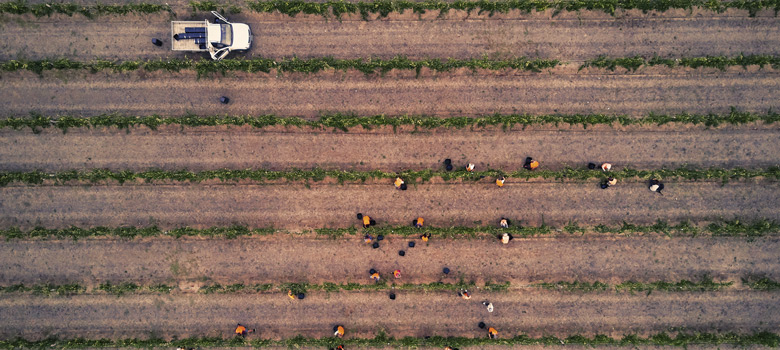
Wine
Diversity in Wine
Diversity is a word that sits well with Australian wine. The continent is large, with a vast range of soils and climates. We also have a wide range of cultures, which are most evident in the food we share, and the wine we drink.
In the 1990s, Australia was known for predictable, consistent, mass-market, well priced, flavoursome wines. Predictable and consistent are great when you turn on a tap, not when you open a bottle of wine. The past two decades have seen Australians embrace the new and the different.
This change parallels Corrina Wright’s winemaking career. Fifteen years ago, she was responsible for producing 18 million bottles annually of Lindemans Bin 65 Chardonnay. Upon returning to her family’s McLaren Vale vineyard, Oliver’s Taranga Vineyard, the technical, hands-on discipline of Lindemans gave way to a low intervention, hands-off approach. At home, this sixth generation winegrower quickly made her mark, producing exemplary regional wines, particularly Shiraz.
But rather than letting this define her, Corrina turned her hand to crafting a diverse selection of alternative varietals including Fiano, Vermentino, Mencia and Sagrantino. “We have ultimate freedom here to do whatever we want. We did our homework and planted heat and drought tolerant varieties, with high natural acidity.”
It was a fine old Barolo that piqued Garry Crittenden’s interest in Italian wines. He tasted widely, read up on Italian wine growing and making methods, then took a pioneering study trip to Piedmont in 1992. The following year, Garry launched his cleverly branded ‘i’ range of Italian varietals with a Great Western-grown Dolcetto.
Meanwhile, Brown Brothers were growing a diverse selection of alternative varieties in their nursery vineyard. These were vinified in small, experimental batches in their ‘kindergarten’ winery, then trial marketed at their cellar door. The food-friendly Italian varietals did well at their restaurant, and the high demand flowed on to local growers. These included Fred Pizzini, who grew Nebbiolo, and his cousin Arnie Pizzini, who grew Barbera, both sources for Crittenden’s ‘i’ wines.
Garry’s studies led to him penning the influential book, Italian Wine Grape Varieties in Australia. This resource helped new growers of Italian wine varietals avoid planting the wrong grapes in the wrong areas. Garry encountered a lot of objections early on, but found the demand for Italian varietals was led by young, open-minded wine-lovers, and enthusiastic sommeliers.
Som’ observations
Australian sommeliers actively seek diverse wines for their lists. Recently named Best Sommelier of Australia, Italian-born Mattia Cianca, has lived and worked here for the past decade. In that time, he has noticed Australians move away from mass-produced wines, to more individual, unique styles and has seen a surge in varietals from his homeland.
Four years at Melbourne’s idiosyncratic Attica restaurant gave Mattia an insight into adventurous Australians’ pursuit of new food and wine experiences. Attica’s philosophy, evocative menu and the mentorship of eccentric head sommelier, Banjo Harris Plane pushed boundaries and made him more courageous.
Mattia is, he describes, “excited by South Australian-grown, southern Italian varietals, like Unico Zelo’s single site Fiano and Brash Higgins’ vibrant, mid-weight Nero d’Avola, which is fermented and aged in clay amphora vessels.”
Empowered Through Education
The Australian Alternative Varietal Wine Show has championed diversity since 2001. In that time, it has provided a platform for less mainstream wines, and witnessed the ongoing rise in wine, exhibitor and class numbers. Pinot G has gone mainstream, and Prosecco will surely follow. The AAVWS shares intelligence via its ‘Talk and Taste’ sessions, where the wine trade gathers to share viticulture, winemaking and marketing experiences.
An increase in structured education has vastly added to Australian wine diversity. The past decade has seen Sommeliers Australia and the Court of Master Sommeliers educate and advance their members’ knowledge and wine service.
Trade initiatives like Negociants’ Working with Wine and the Galli Scholarship programs have provided diversely focussed educational forums, and the Wine & Spirits Education Trust has offered Australians internationally accredited wine levels. This has all broadened the wine trade’s outlook, empowering wholesalers, sommeliers and retailers to list new and diverse wines, giving Australian consumers more choice.
In the Vineyard
There’s also great diversity amongst Australia’s wine regions and vineyards, and how they’re managed. Winemaker Vanya Cullen feels a strong connection to her family’s Margaret River vineyard, where she strives for constant improvement. While it’s always seen minimal chemical inputs, Cullen’s vineyard was certified organic in 2003, then biodynamic in 2005. This has coincided with an increase in vineyard health and fruit quality.
The soils are balanced and alive, allowing roots to plunge deeply to access nutrients. Vanya’s aim is to create a community of living systems and the whole Cullen team are on board. While scientifically trained, Vanya prefers to work with nature to grow quality fruit in a sustainable way. “The illusion is that you can’t farm without chemicals, but the reality is nature.”
As well as being certified biodynamic, the naturally powered Cullen winery is certified carbon neutral. This requires great passion and commitment. All fruit is hand picked according to the biodynamic calendar, then hand sorted, pressed and transferred to barrel, or tank. The yeast is wild, and no artificial cooling, gasses or additions are used. Along with the Margaret River classics, Cullen produce the ‘natural’ Amber – a Sauvignon Blanc made with skin contact in the style of a red wine.
Diversity will continue to describe Australian wine, as long as there are brave winemakers wanting to experiment, and open-minded consumers willing to broaden their taste experiences.